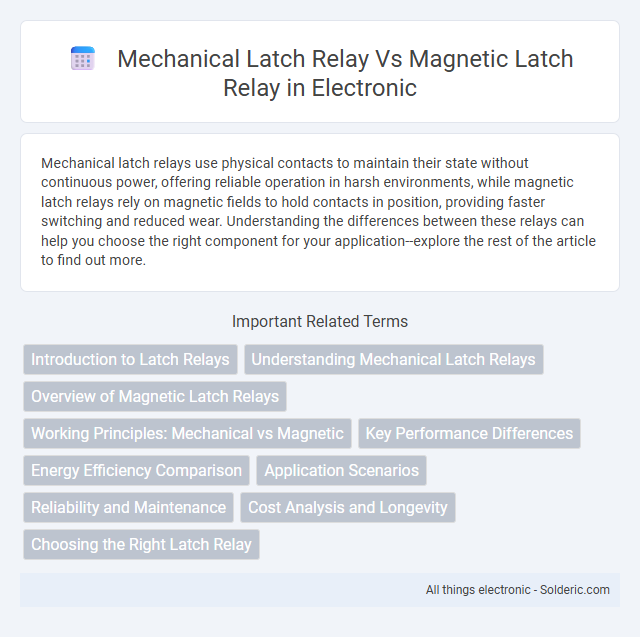Mechanical latch relays use physical contacts to maintain their state without continuous power, offering reliable operation in harsh environments, while magnetic latch relays rely on magnetic fields to hold contacts in position, providing faster switching and reduced wear. Understanding the differences between these relays can help you choose the right component for your application--explore the rest of the article to find out more.
Comparison Table
| Feature | Mechanical Latch Relay | Magnetic Latch Relay |
|---|---|---|
| Operation | Physical mechanical latching via spring and catch | Uses magnetic field to maintain switch position |
| Power Consumption | Power required only during state change | Power required only during state change |
| Switching Speed | Slower due to mechanical movement | Faster switching using magnetic forces |
| Durability | Subject to mechanical wear over time | Less mechanical wear, longer lifespan |
| Holding Force | Dependent on mechanical latch strength | Maintained by magnetic field, consistent force |
| No Power Holding | Retains position without power via mechanical latch | Retains position without power via remanent magnetism |
| Applications | Used in general-purpose switching and latching circuits | Ideal for low power, energy-sensitive applications |
Introduction to Latch Relays
Latch relays, including mechanical latch and magnetic latch types, provide bistable switching by maintaining their position without continuous power, enhancing energy efficiency. Mechanical latch relays operate through physical retention mechanisms, making them reliable for applications requiring sustained contact positions under vibration or shock. Magnetic latch relays use magnetic fields to hold contacts and are ideal for quick switching, offering durability and reduced contact wear in your electrical control systems.
Understanding Mechanical Latch Relays
Mechanical latch relays use a physical mechanism to maintain their position after the coil is energized, providing a stable and reliable switch without continuous power consumption. The mechanical design ensures that the relay stays latched until an opposing signal resets it, making it ideal for applications requiring energy efficiency and a firm state retention. Understanding the operational differences in mechanical latch relays helps you select the best component for circuits where power saving and state preservation are critical.
Overview of Magnetic Latch Relays
Magnetic latch relays use a permanent magnet to maintain the relay's position without continuous power, offering energy efficiency and reducing heat generation compared to mechanical latch relays. These relays provide fast switching speeds and stable contact positions, making them ideal for applications requiring low power consumption and high reliability. Their magnetic mechanism enhances durability by minimizing mechanical wear and extending operational lifespan.
Working Principles: Mechanical vs Magnetic
A Mechanical Latch Relay operates using a physical plunger and spring system that locks the contacts in position, maintaining the state without continuous power. In contrast, a Magnetic Latch Relay relies on magnetic fields generated by coils to hold the contacts, allowing faster switching and reduced mechanical wear. Understanding your application's requirements for durability and switching speed helps determine which latch relay type best suits your needs.
Key Performance Differences
Mechanical latch relays feature physical contacts that maintain their position without continuous power, providing high reliability and low power consumption during static operation. Magnetic latch relays utilize magnetic fields to hold contacts in place, enabling faster switching speeds and reduced mechanical wear, improving response time and lifespan in high-frequency applications. Key performance differences include energy efficiency in mechanical latches versus enhanced switching durability and speed in magnetic latches, making each suitable for distinct industrial and automation environments.
Energy Efficiency Comparison
Mechanical latch relays consume energy only during switching since their contacts maintain position without continuous power, resulting in significant energy savings compared to magnetic latch relays. Magnetic latch relays require a constant magnetic field, often demanding continuous energy to hold contacts, leading to higher power consumption. Energy efficiency in mechanical latch relays makes them preferable for applications requiring minimal power usage and long-term reliability.
Application Scenarios
Mechanical latch relays excel in applications requiring reliable retention of contact position without continuous power, such as industrial automation systems and power distribution panels. Magnetic latch relays are preferred in scenarios demanding faster switching and reduced wear, including telecommunications equipment and remote-controlled devices. Your choice depends on factors like switching speed, power consumption, and endurance in the intended application environment.
Reliability and Maintenance
Mechanical latch relays offer high reliability due to their simple physical contacts but require regular maintenance to prevent contact wear and mechanical failure. Magnetic latch relays provide superior durability and lower maintenance needs as they use magnetic fields to maintain state without continuous power, reducing mechanical stress. Choosing the right relay depends on Your application's demand for long-term reliability and minimal upkeep.
Cost Analysis and Longevity
Mechanical latch relays generally offer lower upfront costs compared to magnetic latch relays, making them suitable for budget-sensitive applications. Magnetic latch relays provide superior longevity due to reduced mechanical wear, resulting in longer operational life and lower maintenance expenses over time. Evaluating total cost of ownership reveals magnetic latch relays often deliver better value in high-cycle or demanding environments despite higher initial investment.
Choosing the Right Latch Relay
Choosing the right latch relay depends on operational requirements: mechanical latch relays offer reliable, cost-effective switching with physical contacts that maintain position without power, ideal for low-frequency switching. Magnetic latch relays utilize magnetic fields to hold contacts, providing faster switching speeds, longer mechanical life, and reduced contact wear, making them suitable for high-frequency applications and precise control systems. Evaluating factors such as switching speed, contact durability, power consumption, and environmental conditions ensures optimal relay selection for specific industrial or electronic applications.
Mechanical Latch Relay vs Magnetic Latch Relay Infographic

 solderic.com
solderic.com